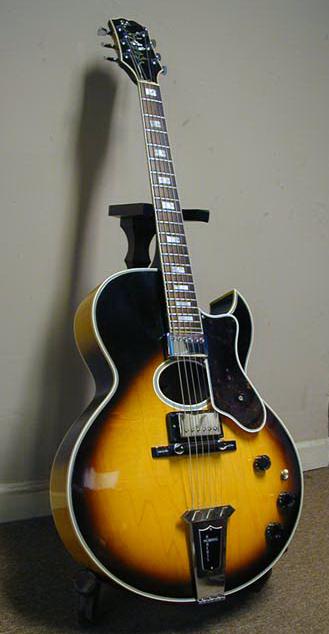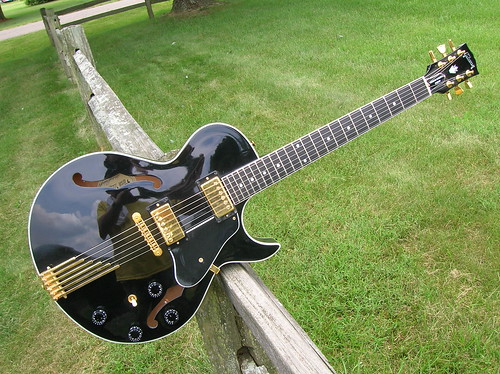He left his mark in the recording industry as well as television. When you hear the Twilight Zone theme, you are hearing Roberts playing guitar. He also played the guitar part on The Munsters TV theme song.
He played rhythm parts for many other shows including I Dream of Jeanie, the Andy Griffith Show, Green Acres, The Beverly Hillbillies, Dragnet and many more.
When it comes to guitars Howard Roberts name is on several fine instruments. Some were custom made and some were mass produced. All were made to his specifications.
Throughout his life, Howard favored Gibson and Epiphone archtop guitars. Early on Howard played an Epiphone Deluxe with a DeArmond pickup. He acquired a Gibson L-5 with a DeArmond pickup attached and later a Gibson L-10.
 |
| Roberts with ES-175 |
Roberts was approached by CMI to design a signature guitar. His goal was to produce a guitar that he could hear over the amplification when he was playing. CMI assigned this to their newly acquired Epiphone division.
You can see Howard's Epiphone cherry red prototype in the classic book American Guitars, by Tom Wheeler. (If you do not own this book - get it!) Roberts thought the Epiphone guitars were too fragile and too expensive. There is a possibility the pickguard vibrated against the top of his instrument. The color pictures in American Guitar show that Roberts stuffed a matchbook between the scratchplate and the body.
CMI assigned Gibson to build the next run of Howard Roberts guitars. The entire body was made of maple on these instruments. The maple tops on the Gibson guitars were laminated. This guitar had a 25.5" scale, which was longer than the Epiphone. There was an option for a second pickup was added at the bridge. The Epi version had a volume and tone control, while the Gibson HR guitars had a volume and tone control, plus a mid-range roll-off control.
Gibson maintained the elaborate headstock pearl inlay, which was on the original Epiphone model. The Gibson version sported a regular sized humbucking pickup or twin humbuckers.
 |
| Epiphone model |
There is also a Gibson Howard Roberts Custom model that was available with a Frequensator tailpiece, which was designed to make the length of the bass strings longer for a tighter feel, and the treble strings shorter for easier lead work.
Next Gibson designed the Howard Roberts Fusion III.
The final Gibson Howard Roberts guitar is the Howard Roberts Fusion. This guitar was made to handle both rock and jazz. It features twin humbucking pickups and a stop tailpiece, which cuts down on amplifier feedback.
The bar pickup was replaced with a P-90, later a humbucker was added to the bridge area. The guitar was painted black with white binding. The control knobs, headstock, pickguard, and tuning keys were all changed.
Howard Roberts designed the H.R. Chroma guitar as a teaching instrument. Only a handful were of these produced. The strings are multi-colored to correspond with the notes in the Howard Roberts Chroma instruction book.
©UniqueGuitar Publications.










Thanx for the write-up about Howard. He was the definitive "Guitar player's guitar player." I was lucky enough to meet, hear, and learn from him on a number of occasions. I'm currently trying to find any info on the Chroma Method; I have a student with a learning disablity and I think this might help him in learning to play. Any help would be great. Thanx: ark3ltd@yahoo.com
ReplyDeleteDoes anyone know the guitar he was using on the "Bullitt Score" with Lalo Schifrin ?
ReplyDeleteI am very amazed by the information of this blog and i am glad i had a look over the blog. thank you so much for sharing such great information.
ReplyDeleteMusic Institute in Lucknow
I am trying to identify this Gibson player...just searching and found your blog about Howards Roberts. Thanks for any help!
ReplyDelete[URL=http://s98.photobucket.com/user/easypics4now/media/UNKNOWN.png.html][IMG]http://i98.photobucket.com/albums/l278/easypics4now/UNKNOWN.png[/IMG][/URL]
I am looking for a chrome pickup cover and neck bracket assembly. Help?
ReplyDeleteRico Mojo richnan@charter.net